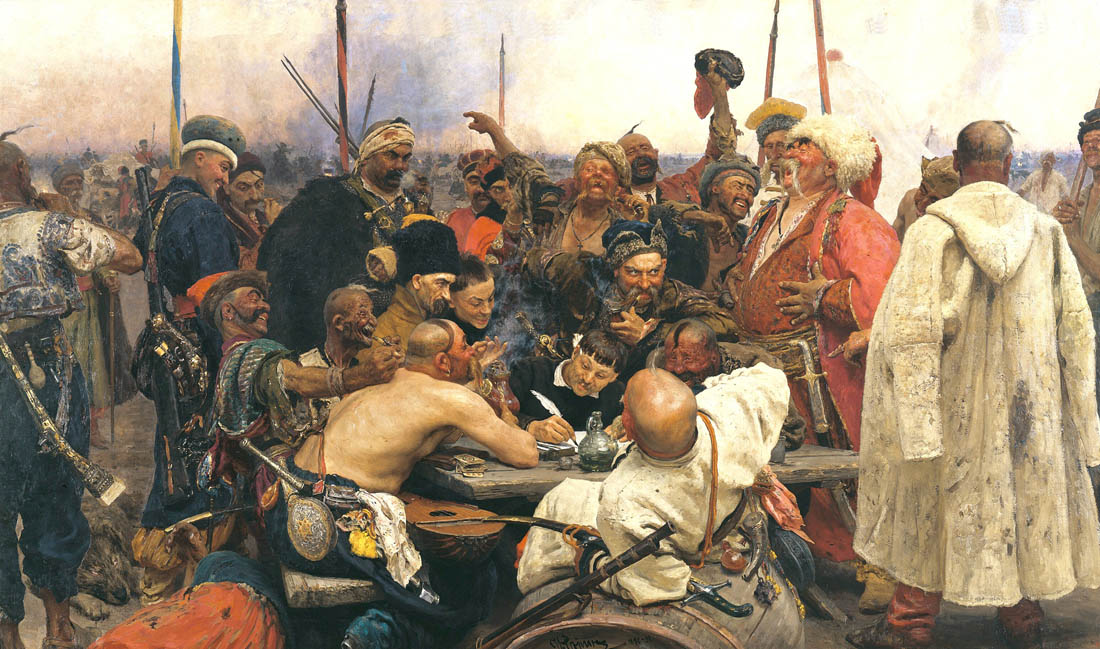THE REPLY OF THE ZAPOROZHIAN COSSACKS TO SULTAN OF TURKEY

- add to my gallery
- about the artist
- how to order a copy
- order a copy
The Artwork Description
Are Drafting a Manifesto (Russian: Запорожцы пишут письмо турецкому султану), is a painting by Russian artist Ilya Repin. The 2.03 m (6 foot 7 inch) by 3.58 m (11 foot 9 inch) canvas was started in 1880 and finished in 1891. Repin recorded the years of work along the lower edge of the canvas. Alexander III bought the painting for 35,000 rubles, at the time the greatest sum ever paid for a Russian painting. Since then, the canvas has been exhibited in the State Russian Museum in Saint Petersburg. Vladimir Gilyarovsky, a popular journalist, was one of the models who posed for Repin.
Reply of the Zaporozhian Cossacks depicts a supposedly historical tableau, set in 1676, and based on the legend of Cossacks sending a reply to an ultimatum of the Sultan of the Ottoman Empire, Mehmed IV. The original reply has not survived; however, in the 1870s an amateur ethnographer from Yekaterinoslav (today Dnipropetrovsk), Ya. Novitsky, found a copy made in the 18th century. He gave it to historian Dmytro Yavornytsky (1855-1940), who by chance read it to his guests, among whom was the painter Ilya Repin. Repin became curious about the story and in 1880 started the first of his studies.[citation needed]
Zaporozhian Cossacks (from 'beyond the rapids', Ukrainian: za porohamy), inhabiting the lands around the lower Dnieper River in Ukraine, had defeated Ottoman Empire forces in battle. However, Mehmed demanded that the Cossacks submit to Turkish rule. The Cossacks, led by Ivan Sirko, replied in an uncharacteristic manner: they wrote a letter, replete with insults and profanities. The painting exhibits the Cossacks' pleasure at striving to come up with ever more base vulgarities. During Repin's time, the Cossacks enjoyed great popular sympathy. Repin also admired them: "All that Gogol wrote about them is true! A holy people! No one in the world held so deeply freedom, equality, and fraternity."[1]
As the Sultan; son of Muhammad; brother of the sun and moon; grandson and viceroy of God; ruler of the kingdoms of Macedonia, Babylon, Jerusalem, Upper and Lower Egypt; emperor of emperors; sovereign of sovereigns; extraordinary knight, never defeated; steadfast guardian of the tomb of Jesus Christ; trustee chosen by God Himself; the hope and comfort of Muslims; confounder and great defender of Christians - I command you, the Zaporogian Cossacks, to submit to me voluntarily and without any resistance, and to desist from troubling me with your attacks.
The Cossacks' reply came as a stream of invective and vulgar rhymes, parodying the Sultan's titles:
Zaporozhian Cossacks to the Turkish Sultan!
O sultan, Turkish devil and damned devil's kith and kin, secretary to Lucifer himself. What the devil kind of knight are you, that can't slay a hedgehog with your naked arse? The devil excretes, and your army eats. You will not, you son of a bitch, make subjects of Christian sons; we've no fear of your army, by land and by sea we will battle with thee, fuck your mother.
You Babylonian scullion, Macedonian wheelwright, brewer of Jerusalem, goat-fucker of Alexandria, swineherd of Greater and Lesser Egypt, pig of Armenia, Podolian thief, catamite of Tartary, hangman of Kamyanets, and fool of all the world and underworld, an idiot before God, grandson of the Serpent, and the crick in our dick. Pig's snout, mare's arse, slaughterhouse cur, unchristened brow, screw your own mother!
So the Zaporozhians declare, you lowlife. You won't even be herding pigs for the Christians. Now we'll conclude, for we don't know the date and don't own a calendar; the moon's in the sky, the year with the Lord, the day's the same over here as it is over there; for this kiss our arse!
While working on the original version, Repin in 1889 began work on a second version. This work he never finished. The second version of "The Cossacks" the artist tried to make more "historically authentic". In 1932 it was presented by the Tretyakov Gallery to the Kharkiv Historical Museum. In 1935, it was moved to the Kharkiv Art Museum, where it is now stored. This canvas is slightly inferior in size and quality[original research?] to the original version, and is, as it were, the unofficial variant.
From Wikipedia, the free encyclopedia



Comments